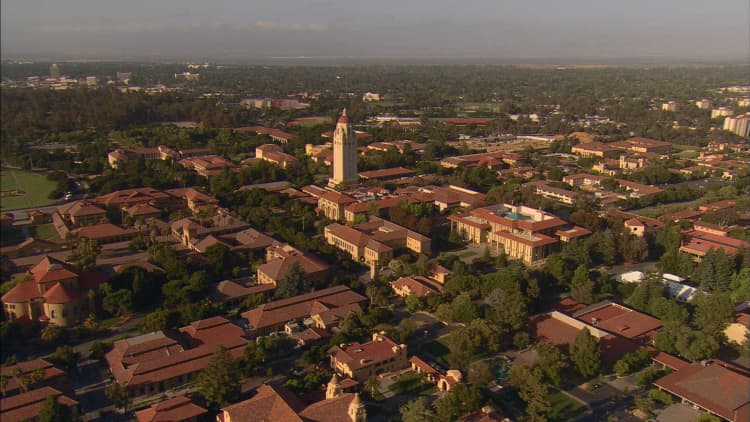Snap Inc. founder and CEO Evan Spiegel was not the best high school student. Even though he didn't rank at the top of his class, college admissions expert Danny Ruderman made him apply to Stanford, one of the most selective colleges in the country.
Notably, Stanford accepts only five percent of applicants and the average SAT score of an accepted student is between 1390 and 1540.
"One of my students was Evan Spiegel, the founder of Snapchat," Ruderman tells CNBC Make It. "He didn't want to apply to Stanford because he didn't think he would get in and I made him apply."
Even though Spiegel didn't think he would be able to get into the highly-selective school, Ruderman thought Spiegel would be the perfect fit. It also probably didn't hurt that Spiegel's father had also attended Stanford.
"The reason I made him apply is because he had three to four years of graphic design work and a really incredible portfolio. Stanford has a really good product design program. Based on everything about him, it's not surprising. His essay, his portfolio was a perfect match for that program," he explains. "They were looking for kids who think outside the box and who had design work."
"It wasn't that he was the absolute best student in his school, it was that he had a set of qualities and interests that matched something that Stanford wanted," says Ruderman.
Fortunately, Stanford felt the same way as Ruderman. "Of course he got in, and that's where he went, and that's where found his partner Bobby, and that's where they founded Snapchat," he says.
Even though Spiegel never actually graduated from Stanford (he dropped out just a few credits short of earning a degree), he feels fortunate to have attended. At a Stanford Women in Business conference, he said, "I am a young, white, educated male who 'got really, really lucky."
Ruderman's determination to make Spiegel apply to Stanford came from his own personal experience. "I went to a public high school in Southern California that sent 17 percent of students to college. My principal didn't think I would ever get into Stanford because the academic reputation of my school was so poor," says Ruderman. "I applied and got in anyway."
"I tell that not because it's a 'Danny got into Stanford' story but because it fuels how I do this job," Ruderman explains.
Beating the odds taught the college admissions expert two important lessons. "On one hand, I believe if you don't ask, you can't get," he says. "On the other hand, I don't care about the name of a school."
Finding a college that is a perfect match is the best way for students to make sure that they matriculate to the right school for them, says Ruderman. "For me, it's all about finding a match. What matches up with their interest and also how to help the kid be more authentic," he says. "Because authenticity is the real way that students can actually stand out."
Figuring out who your authentic self is can be a difficult task for a high school student. "Danny totally had my back and helped me express who I really was — no easy task in such a high-growth phase of life," Spiegel says.
Like this story? Like CNBC Make It on Facebook
Don't miss:
The 5 most valuable college majors
These are the 10 best community colleges in the country
This is the age most Americans pay off their student loans



